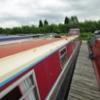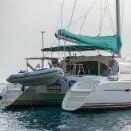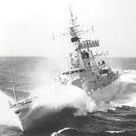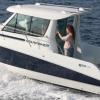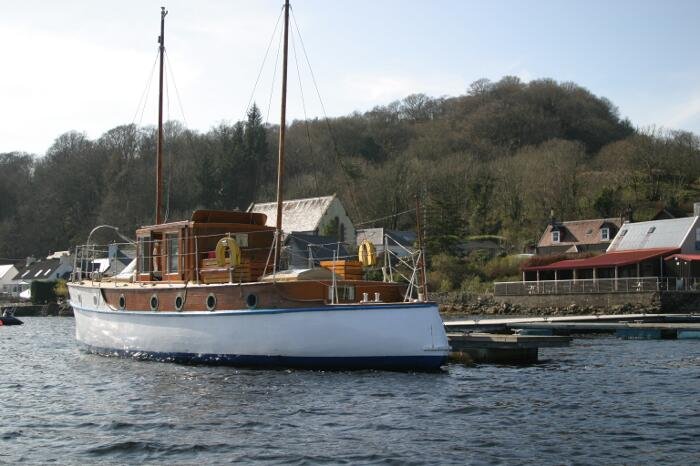Leaderboard
Popular Content
Showing content with the highest reputation on 05/05/18 in all areas
-
Thank you jamboat. Little dog is apparently now on another boat, heading up to find the owners. Think this is a 'job done' case. Thanks again3 points
-
2 points
-
This post cannot be displayed because it is in a forum which requires at least 10 posts to view.
-
This post cannot be displayed because it is in a forum which requires at least 10 posts to view.
-
In my experience an unexpected re-branding for no obvious reason is usually displacement activity on the part of the board, in a (usually) vain attempt to save a failing company instead of taking decisive management action to fix the mounting problems.1 point
-
No it isn't. We used to install hundreds of battery banks for telephone exchange backup, thousands of amps at 48 volts and all the battery makers insisted on proper terminal grease on every cleaned connection before fitting with the excess wiped off after fitting. And they should know, they have to guarantee the batteries on pain of immense liability. The grease does not interfere with the connection as long as it is clean and tight. Smearing it all over the outside of the clamp is a garage con trick to look as though they care, but not enough to strip and clean the connection.1 point
-
1 point
-
No, battery terminal dressing or Vaseline applied to the post before fitting the clamps. Any that squeezes out spread over the clamp (especially the threads) and any exposed conductors where the insulation has shrunk back. The idea is that it is all but impossible to stop acid weeping up the post/lid seal and with Vaseline filling any gaps between clamp and post the acid can not get to the interface and cause corrosion. Sticking grease on the outside of the clamps is a modern idea from the motor trade where its easy to do and shows the customer something has been done.1 point
-
We're right by Drinkwater swing bridge (231) on south Oxford. Small dog found on towpath and eventually caught. Has a name tag, with boat and dog name Coco. He/she is being cared for on boat about 5 back from the swing bridge, boat name Doolally. Please pass this on if you know the owner, thank you1 point
-
I’ve copied this to the “dogs on the Cut” & “friendly narrowboaters” Facebook pages1 point
-
I agree its a strong possibility ... if it happens i would take the fuel filler cap off ... you will probably hear it suck as you release the pressure .... and it should then run as normal, easy check just to rule it out. Rick1 point
-
I bet it's coal really, and they just whitewashed the bags. Cheers, MP.1 point
-
No point in arguing but some of those extracts contain even more bullshine. Virtually ALL inland reputable marinisations circulate the cooling water through the exhaust manifold jacket and have done for years - that is apart from the Barrus Shanks and some Ford XLDs so that quotation can only be marketing. Item 6 - Twin Thermostats Stick a 71 degree stat in a single stat engine and virtually the same will apply and any slower warm up will be marginal as experience shows. In fact may direct raw water cooled engines run with an even lower thermostat without any more noticeable exhaust smoke or reduction in engine life. Virtually all vehicles, plant and agricultural vehicles use single thermostats again without any more noticeable smoke, extended warm up time or reduction in life so we have to ask what is so special about those particular Shire engines because I am sure most Yanmar engines operate with single stats. One answer could be that they are direct injected and direct injected engines will tend to smoke a bit at low speed, low power and idle. It seems to me that Barrus may be complicating things because of an arguable problem with their chosen base engine. I also note that Barrus demand 15 minutes of full speed/load running whilst tied up every 50 hours. - directly contrary to C&RT regulations. As I also have a direct injected engine it is clear to me this is an attempt to hide the base engines shortcomings for canal use. That is not to say direct injection is an absolutely wrong choice, it has some advantages like better cod starting without extra aids and better fuel consumption at higher speeds. rather than tell the truth its seems we fed more bullshine. I would suggest that rather than believing everything you are fed you start to do some critical thinking and research.1 point
-
1 point
-
You've missed it, you passed Barby a few miles back. Oh, you meant barbeque? Maybe you've also mis-spelt that word I learnt this week, and are planning to cook a castrated male sheep? I couldn't eat a whole one. On Tuesday I get to do my first proper bit of boating of the year, if I don't count about four miles with no locks that I did (two return trips through the Islington tunnel), and a move of about 80 feet at Alvecote last weekend.1 point
-
Not where we are. Just spent a lovely morning at Neilston country show and are now heading to Irvine for an afternoon by the coast. Lovely mild day.1 point
-
You can make your own. I've made a few like this. Drain the oil out completely. Refill with the correct amount, in your case around 7 1/2 to 8 pints. A length of 1/8'' welding rod to make a new one and a stop collar, I use Meccano collars or small Meccano pulley. Slide the collar onto the rod. Pop the rod into the tube until it hits the sump, pull it up about an inch and tighten the collar, pull it out, wipe it and reinsert. Pull out and you now have the FULL level. Mark it with a stroke or two with a junior hacksaw. Mark it again about 1/2'' lower down for a LOW mark. Bend the top of the rod into a finger loop or L. A small O ring can be sild up under the collar. Voila, one dipstick.1 point
-
Plus, in some facilities virtually impossible to get suitable access1 point
-
I think we need to get one thing straight, the notion that rusting does not occur on the baseplate is clearly nonsense. In fact the popular view that the waterline is the most vulnerable area doesn't stand up to any examination of the evidence either. The issue is whether it is worth the trouble of blacking it, given the vulnerable environment the bottom of a narrowboat lives in and as David says, the fact that it is an extremely unpleasant job. A lot of folk are swayed by the anecdotes about elderly boats where the unprotected bottom still looks like new. I think this could very well be the case with certain deep draughted boats, say 2'6 and greater where the baseplate is getting scoured on a regular basis and rust never gets a hold. But modern shallow draught boats generally float well clear of the canal bottom, unless you happen to do most of your boating on the Ashby or the HNC. So, my proposition is don't bother if you have a heavy deep draughted boat (that might well have a bottom plate in excess of the normal 10mm anyway) but consider it worthwhile if you think your boat floats well clear of the canal bottom most of the time.1 point
-
Clearly the water line is the most important bit. But if you have pitting on the bottom plate, then effective cleaning and blacking will reduce the chances of the pits growing to the point where they come out the other side of the plate, even if all the high points got polished fairly rapidly. The main reason most people don't black the bottom is because it is a pretty unpleasant job.1 point
-
1 point
-
Why not just stop your cruise at a convenient spot, give a man some money, lie back and enjoy the sunshine and watch someone working, 7 days later continue your cruise. Take things easy - why complicate life.1 point
-
No probably definitely get some Vactan . Apply that to any rusted areas after you have wire brushed it . Like others have commented I find using a brush gets a thicker layer of paint on particularly in any areas that are pitted. It is a messy job but take plenty of before and after photographs and it makes it all worthwhile. I use Sealex B as a coating and have been happy with it although if the weather is cold it needs warming up to make it easier to apply .1 point
-
A header tank can in no way stop a Webasto cycling. The heater WILL cycle when the heat being extracted from the water is less than the heat the boiler is putting into the water. It's running it for just 3/4 h0ur that stops it cycling. Leave it longer and it will eventually cycle. At first the cold water in the calorifier will extract lots of heat from the Webasto circuit so the Webasto runs flat out. As the calorifier warm sup it extracts less and less heat as the relative temperatures of the Webasto water and calorifier water gets closer to each other. When they are the same almost no heat will be extracted and the Webasto will cycle to stop the water in the boiler actually boiling. It's basic physics.1 point
-
This post cannot be displayed because it is in a forum which requires at least 10 posts to view.
-
Whilst the boat is out of the water check. 1. Prop and rudder 2. Anodes 3. Stern gland packing ok.1 point
-
Pretty good then and just as a side comment 18 million hobby and hire boats passed us late afternoon /evening and the worst for belting past was a shiney private boat and the best by far were two willow wren boats together full of Pirate stags drinking beer, both boats of which passed on dead tickover barely making a ripple. Being a sad git and because of using the forum a lot I honestly noticed on balance the hire boats ( In general ) were the ones slowing or as should be at tickover when passing.1 point
-
I'd just like to point out that ex GUCCC Belfast 115, registered at Brentford on 9 December 1936, the day before HMS Belfast's keel was laid down, does not have any guns!1 point
-
Good option. But also you might be saving just £50 quid doing it yourself. When the boat is in dry dock or hard standing you could do lots of other jobs while the yard does the blacking. Painting the counter bands, or gunnels or welding something or whatever.1 point
-
This post cannot be displayed because it is in a forum which requires at least 10 posts to view.
-
I can’t resist. I cannot see the point in blacking the baseplate, there’s no light, and no oxygen there. The interface between the water and the air along the sides of the boat seems to me to be the place where it is important to have good blacking and good anodes. A short cruise down some of our shallower canals ( a lot of them these days) will remove the blacking from the bottom plate fairly quickly.1 point
-
Every few weeks cars are broken into either in the secluded car-park or on the lay-by. The most recent, before this was a panel van about 3 weeks ago - the culprits went in through the front window and broke out the wooden partition the owner had fitted. Boats on the long-term mooring have lost generators. Cars have had tyres slashed. Very few of these crimes are reported. Just today someone - talking about another incident - said that there was no point, all you got was a crime number. I suspect you are right - thought it was worth the punt. If nothing else it reminds us to keep valuables out of sight when travelling.1 point
-
Please start to study answers you have already been given and if you can't understand come back and explain what you do not understand. I note that you seem to have taken my guess at 110Ah domestic battery as an absolute recommendation. IT IS NOT. You also refuse to supply photos when requested. We all now how difficult it is and what a steep learning curve a new boater who is not very technically aware faces and want to help but you must do your part as well by answering questions when asked and taking some trouble to understand the answers you are given. If you go on a syou seem to be then you will get labelled as a Troll and no one will bother trying to help. 1. Turning a red switch OFF and then managing to start the boat apparently by using a battery makes no sense at all. It suggests all may not be well with your boat. 2. We still have no proof or confirmation that you actually do have a split charging system. There is every possibility both/ all your batteries supply both the domestic system (lights, water pump etc) AND starts the engine. You have been asked for photos of the batteries and wiring but so far have failed to send them. 3. I and others have explained that a battery bank size depends upon two things: your electrical demand and the your ability to fully recharge. Then you have to juggle the charging process to get them to balance. Again I have pointed you to stuff that sows how it can be done. If you ignore this you are likely to: Ruin batteries in a short time or run out of electricity. You have failed to provide any idea about how much electricity you use each day and what your charging regime is so you are still asking questions that are impossible to answer. No one who has knowledge is likely give you figures when they know so little. 4. You have been asked for the MAKE (now provided) and MODEL of the outboard so even if you do not know its charging output we can look it up. At present what you have given us is 20hp. That is not a model and it will be all but impossible to find the charging output without a year at least, even then it will be difficult. 5. I am NOT going to have a guess at the size of the other battery because if I do it seem you will ignore everything else and take it as gospel. a domestic battery. Remember it is not even clear that you do have a start battery and a domestic battery, they may both do both jobs. If they are separate then we need to know how the charge is split so we can advise on the optimum system. Again photos of all the electrical switches and "gubbins" near the batteries and engine may be required. 6. To be honest I strongly suspect that you may intend to live aboard this boat and if so I can be fairly confident in forecasting ongoing battery problems and endless cost. PLEASE can we get the basics sorted. We must know if its two battery banks or one battery bank of two batteries. Then we need your electrical consumption and charging details. At present I feel very reluctant to waste any more time trying to explain things to you and then be ignored or you doing a pick mix job.1 point
-
Why don't you just run the engine ? My calorifier will heat up from cold in just 30 mins. My engine is a Barrus Shire 45 with dual thermostats so once it gets up to 71 degrees all its hot water is directed to the calorifier. When the engine gets to 82 degrees it is directed to the skin tank. Excellent system imo.1 point
-
This post cannot be displayed because it is in a forum which requires at least 10 posts to view.
-
This post cannot be displayed because it is in a forum which requires at least 10 posts to view.
-
1 point
-
Blimey I couldn't disagree more. I guess I am in the minority though...Hence the Clonecraft generic narrowboat. Personally I would much rather compromise on living space and practicality than live in a floating box. Sloping walls, high maintenance, smaller cabins but give me this over any ugly fat narrowboat ...1 point
-
This post cannot be displayed because it is in a forum which requires at least 10 posts to view.
-
This post cannot be displayed because it is in a forum which requires at least 10 posts to view.
This leaderboard is set to London/GMT+01:00







